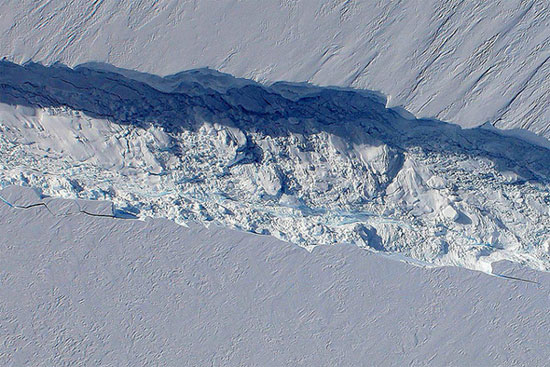Discovering the 'massive' iceberg in Antarctica
A giant iceberg, about eight times the size of Manhattan (USA) and across the city of Hamburg (Germany), broke out in an Antarctic glacier.
Germany's TerraSAR-X earth observation satellites detect a giant iceberg as it separates from the Pine Island glacier. Scientists say this is the result of a giant crack discovered in 2011, this crack created an iceberg of 720km 2 in size.

Giant cracks on the Pine Island glacier.(Photo: Wikimedia Commos)
Mr. Angelika Humbert, an ice researcher at Alfred Wegener Academy in Bremerhaven, Germany, said: "The ice sheets are born from the flow of glaciers and as large as the city of Hamburg."
According to experts, large ice sheets are often separated from glaciers every 6 to 10 years, and similarly remarkable events happened in 2007 and 2011. Icebergs are not considered a Part of the result of global warming. However, glaciers are still the source of about 10% of all ice sheets melting west of Antarctica.
Natureworldnews quoted David Vaughan from the British Antarctic survey team to BBC: 'Pine Island is the fastest-shrinking glacier on the planet, it loses more ice than any other glacier and it contributes to the water level. Sea increases rapidly '.
Pine Island Glacier is a large ice stream in the Amundsen Sea, which accounts for about 10% of the area in the west of Antarctica. This glacier was discovered by the US Geological Survey and the US Navy in 1960-1969 with aerial photographs.
- The iceberg is about the size of Singapore
- 4 scenario is happening when the largest iceberg in history has just broken in Antarctica
- The ice is as big as London in 'wobbly teeth' apart from Antarctica
- What will happen to NASA's ever-hot rectangular iceberg?
- The world's largest iceberg is at risk of breaking away from Antarctica
- The one trillion tons of ice has separated from Antarctica
- Add a giant iceberg from Antarctica
- Video: Consequences of 1,000 billion tons of icebergs separated from Antarctica
- The coffin-shaped iceberg is about to disappear after 18 years
- The strange ice sheets in Antarctica
- Antarctica: Ice is breaking down from below
- Discover the giant 'iceberg city' in Antarctica
 Is the magnetic North Pole shift dangerous to humanity?
Is the magnetic North Pole shift dangerous to humanity? Washington legalizes the recycling of human bodies into fertilizer
Washington legalizes the recycling of human bodies into fertilizer Lightning stone - the mysterious guest
Lightning stone - the mysterious guest Stunned by the mysterious sunset, strange appearance
Stunned by the mysterious sunset, strange appearance